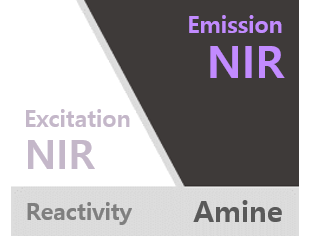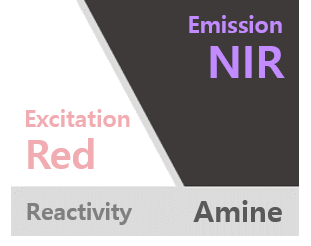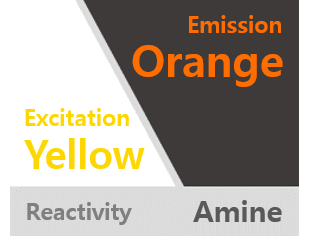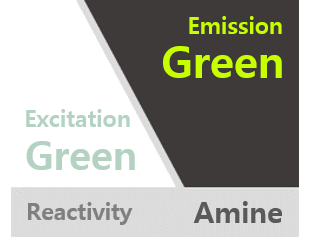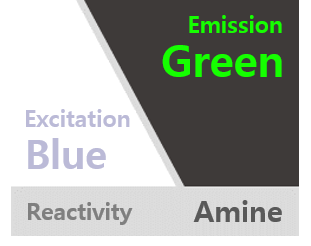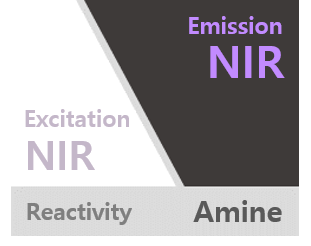
FSD Fluor™ 488 NHS ester
| PACKING UNIT | price |
Lead time |
|---|---|---|
| 1 mg | $273.00 | |
| 5 mg | $1,082.00 | |
| 25 mg | $3,378.00 |
Description
FSD Fluor™ 488 NHS ester is the new generation of amine reactive bright green dye developed by BioActs’ cutting-edge technology displaying excellent optical property comparing to spectrally similar dyes. The fluorescence intensity after binding to biomolecules such as antibody, nucleotide, and protein is also excellent, thus FSD Fluor™ series is ideal for various biochemical and biological analytical applications. FSD dye is conceivably the best existent dye for single-molecular detection of bioconjugates for fluorescence correlation spectroscopy and for fluorescence polarization measurements.The maxima of Ex/Em values are at 495/519 nm, similar to that of Fluorescein. FSD 488 might be excited using 488 nm laser line and displays excellent optical property. FSD 488 can be conjugated to low-abundance biomolecules with great sensitivity and high molar ratios, allowing sensitive detection. NHS esters readily react with amine-modified oligonucleotides or amino groups of proteins, i.e. the ε-amino groups of lysine or the amine terminus of nucleotides to form a chemically stable amide bond between dye and the biomolecule. We offer FSD Fluor™ 488 NHS ester for labeling of antibodies, peptides, proteins, ligands, and amplification substrates optimized for cellular labeling and detection.
Citation & Reference
1. Le NT, Viscosity regulation of chemically simple condensates. Biomacromolecules. 2024 Aug 21;25(9):5959–67.
2. Jeon H-J, N-methyl-D-aspartate receptors induce M1 polarization of macrophages: Feasibility of targeted imaging in inflammatory response in vivo. Cell & Bioscience. 2023 Mar 30;13(1).
3. Mathew AP,Hyaluronan-coated Prussian blue nanoparticles relieve LPS-induced peritonitis by suppressing oxidative species generation in tissue-resident macrophages. Biomaterials Science. 2022;10(5):1248–56.
4. Han SJ, Electric fields regulate cellular elasticity through intracellular Ca2+ concentrations. Journal of Cellular Physiology. 2021 May 16;236(11):7450–63.
5. Yhee, Ji Young. Cancer-targeted MDR-1 siRNA delivery using self-cross-linked glycol chitosan nanoparticles to overcome drug resistance. Journal of Controlled Release 198 (2015): 1-9.
6. Lee, Eunjung. Co-delivery of chemosensitizing siRNA and an anticancer agent via multiple monocomplexation-induced hydrophobic association. Journal of Controlled Release 210 (2015): 105-114.
7. Park, Solji. Amphiphilized poly (ethyleneimine) nanoparticles: a versatile multi-cargo carrier with enhanced tumor-homing efficiency and biocompatibility. Journal of Materials Chemistry B 3.2 (2015): 198-206.
8. Hollis, Christin P. In vivo investigation of hybrid paclitaxel nanocrystals with dual fluorescent probes for cancer theranostics. Pharmaceutical research 31.6 (2014): 1450-1459.
9. Yoon, Hong Yeol. Glycol chitosan nanoparticles as specialized cancer therapeutic vehicles: Sequential delivery of doxorubicin and Bcl-2 siRNA. Scientific reports 4 (2014).
10. Oh, Keun Sang. Accurate sequential detection of primary tumor and metastatic lymphatics using a temperature-induced phase transition nanoparticulate system. International journal of nanomedicine 9 (2014): 2955.
11. Lee, So Jin. TNF-α gene silencing using polymerized siRNA/thiolated glycol chitosan nanoparticles for rheumatoid arthritis. Molecular Therapy 22.2 (2014): 397-408.
12. Yoon, Hong Yeol. Bioreducible hyaluronic acid conjugates as siRNA carrier for tumor targeting. Journal of Controlled Release 172.3 (2013): 653-661.
13. Yhee, Ji Young. Tumor-targeting transferrin nanoparticles for systemic polymerized siRNA delivery in tumor-bearing mice. Bioconjugate chemistry 24.11 (2013): 1850-1860.
14. Yoon, Hong Yeol. Photo-crosslinked hyaluronic acid nanoparticles with improved stability for in vivo tumor-targeted drug delivery. Biomaterials 34.21 (2013): 5273-5280.
15. Keunsoo Jeong. Poly (oxyethylene sugaramide) s: unprecedented multihydroxyl building blocks for tumor-homing nanoassembly. Journal of Materials Chemistry B 1.28 (2013): 3437-3442.
16. Park, Jin Woo. Wide-Ranged Fluorescent Molecular Weight Size Markers for Electrophoresis. Bulletin of the Korean Chemical Society 34.1 (2013): 29-30.
17. Huang, Xinglu. Multiplex Imaging of an Intracellular Proteolytic Cascade by using a Broad Spectrum Nanoquencher. Angewandte Chemie International Edition 51.7 (2012): 1625-1630.
18. Koo, Heebeom. The movement of self-assembled amphiphilic polymeric nanoparticles in the vitreous and retina after intravitreal injection. Biomaterials 33.12 (2012): 3485-3493.
19. Zhu, Lei. Real-time monitoring of caspase cascade activation in living cells. Journal of controlled release 163.1 (2012): 55-62.
20. Lim, Chang-Keun. Gadolinium-coordinated elastic nanogels for in vivo tumor targeting and imaging. Biomaterials 34.28 (2013): 6846-6852.
21. Lim, Chang-Keun. Phthalocyanine-aggregated polymeric nanoparticles as tumor-homing near-infrared absorbers for photothermal therapy of cancer. Theranostics 2.9 (2012): 871-879.
22. Park, Jin Woo. Novel cyanine dyes with vinylsulfone group for labeling biomolecules. Bioconjugate chemistry 23.3 (2012): 350-362.
23. Ryu, Ju Hee. Early diagnosis of arthritis in mice with collagen?induced arthritis, using a fluorogenic matrix metalloproteinase 3–specific polymeric probe. Arthritis & Rheumatism 63.12 (2011): 3824-3832.
24. Ibrahim, Basma M. A strategy to deliver genes to cystic fibrosis lungs: a battle with environment. Journal of controlled release 155.2 (2011): 289-295.
25. Xu, Peisheng. Zwitterionic chitosan derivatives for pH-sensitive stealth coating. Biomacromolecules 11.9 (2010): 2352-2358.
OPTION
Total

 log
log My
My Contact
Contact

